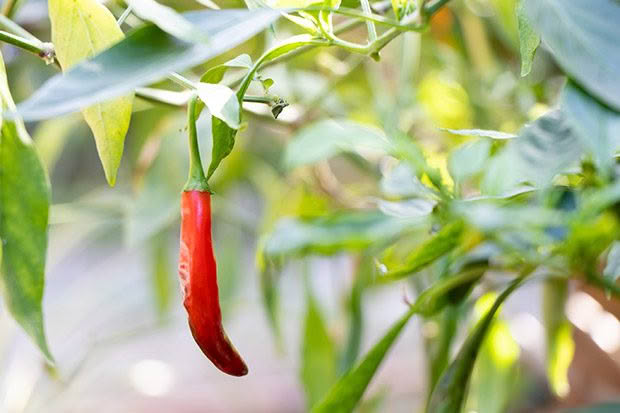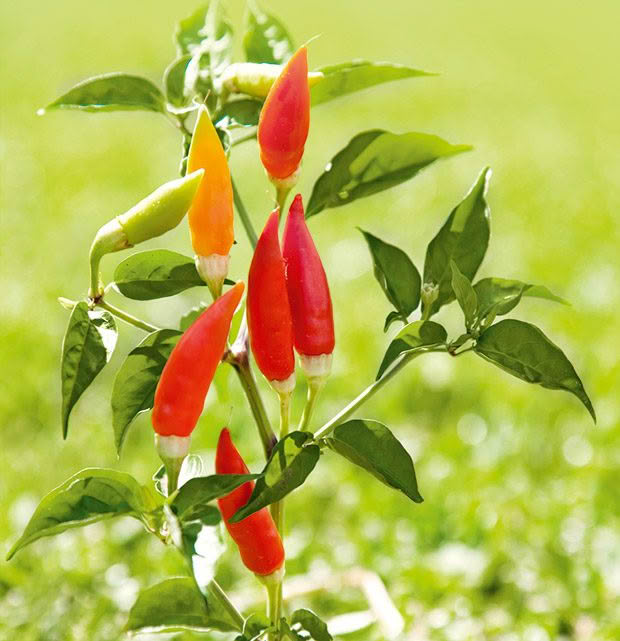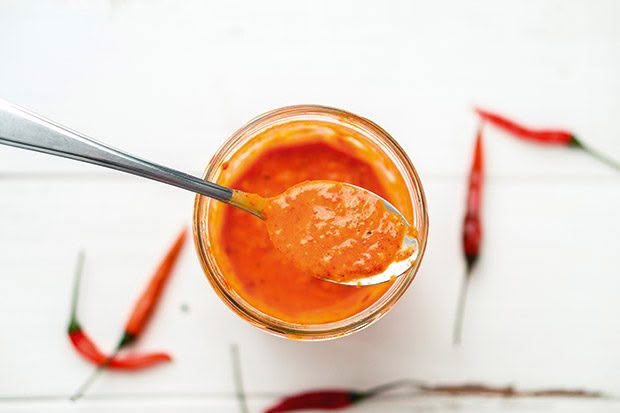Make this spicy peri peri sauce with your homegrown chillies

Drizzle this homemade sauce on anything from skewers, roasts, and burgers — or use as a spiced up marinade.
Words: Kristina Jensen
Chilli sauce-makers are a creative lot when it comes to naming their products. Some of the punniest ones I’ve seen include Rectal Rampage, Weapon of Ass Destruction, Let One Rip, No Wimps Allowed Hot Sauce, Satan’s Blood, and the very cringey Smack My Ass & Call Me Sally. There’s seemingly no end (pun intended) to the possibilities.
I’m not a chilli fan. It’s unlikely that I’ll ever subject my gut to the kind of assault these names suggest. A sauce that tastes delightfully hot and spicy to my husband represents only pain and suffering for me.
However, I’m fascinated by the desire of those who love chillies – aka chilli heads – to subject their senses to ‘the burn’. I’ve always thought a good chilli sauce had just two qualities to recommend it – heat and flavour – but it’s a lot more complicated than that.
It’s technically all about sensation. Humans have specific receptors for heat, as in hot temperatures. But these sensors react in the same way to the ‘heat’ produced when eating chillies, black pepper, ginger, wasabi, and other ‘hot’ foods. Your mouth feels like it’s burning – check out the box at right as to why – and some people enjoy this sensation.

Chilli fans have a way of talking about and comparing chillies. A pepper’s heat is defined by its intensity, and four other factors:
• how the heat starts, ie is it instant or does it build up?;
• how long the burning sensation lasts;
• where it hits you, physically;
• whether it has a ‘sharp’ or ‘flat’ quality.
Sharp feels like jabbing pins in your mouth. Flat is more like having the heat painted onto your tongue or smeared around the inside of your mouth. I’m not a thrillseeker or a masochist, but I do make a good peri peri sauce for the one I’m married to.
WHAT HAPPENS WHEN YOU FEEL THE BURN
There are plenty of videos online of people eating super-hot chillies. Most people start confidently but quickly begin burping and sweating. That’s because the ‘hot’ ingredient in chillies – capsaicin – stimulates a pain response, not a taste response, says Dr John Prescott, experimental psychologist and the author of Taste Matters. The capsaicin binds to pain nerve fibres on the lips, mouth, and tongue, causing inflammation.
Mucous membranes are stimulated to flush it out, causing the nose and eyes to run and a watering mouth. By this time, your brain believes your body is burning. You start sweating, and blood vessels on the skin dilate to help with cooling, giving you a flushed appearance. Yoghurt and creamy milk help relieve the pain as capsaicin is fat-soluble.
Source: vice.com
SPICE UP YOUR LIFE
People don’t derive pleasure from eating boiling hot food – which stimulates the same pain sensors as chillies – but they willingly and often joyfully eat searingly hot, spicy dishes.
Research shows some people have fewer receptors to the pain caused by capsaicin, making them more tolerant of very spicy foods.
However, there’s also a nurture aspect. If you want to improve your tolerance to hot food such as chillies, the trick is to eat it more often. By continually exposing pain receptors to capsaicin, you physically change your nerve endings. This eventually desensitises them, allowing you to eat more spicy food without such an intense pain sensation.
Over time, nerve endings degrade, a phenomenon that scientists still don’t fully understand.
Source: Is spice tolerance genetic?, psomagen.com
Recipe: Hot-As Peri Peri Sauce

Peri peri sauce is of Portuguese-African origin. The chilli variety you use is essential for the heat, but equally so is the amount of salt, the acid (vinegar and/or lemon juice), and the aromatics (carrots, onions, garlic, apple, etc). Some people are very particular about the variety of chilli they use; I prefer the deep rich flavour of habeneros, but you can choose your own heat level.
Makes: 3 cups
Time: 30 minutes
INGREDIENTS
1 cup chopped chillies of your choice
2 red onions
1 bulb of garlic
2 red capsicums
3 ripe tomatoes (use a sauce variety)
3 lemons
4 tbsp olive oil
⅓ cup red wine vinegar
2 tbsp sugar
1 tbsp salt
1 tsp cracked black pepper
2 bay leaves
1 tbsp dried oregano
1 tbsp smoked paprika
METHOD
Peel and roughly chop the onions, garlic, and capsicums. Remove the stems from the chillies. Juice and zest the lemons.
Tip all the ingredients into a food processor and mix until at your preferred consistency (ie, smooth, chunky) – it will mix to a thick paste, so if you want it runnier, add a little water or olive oil.
Simmer in a saucepan on a medium heat for 20 minutes. Stir regularly to prevent burning. Taste and adjust the seasoning if required. Will keep (in a sterilised jar) in the fridge for up to 2 weeks.
Love this story? Subscribe now!
 This article first appeared in NZ Life & Leisure Magazine.
This article first appeared in NZ Life & Leisure Magazine.
